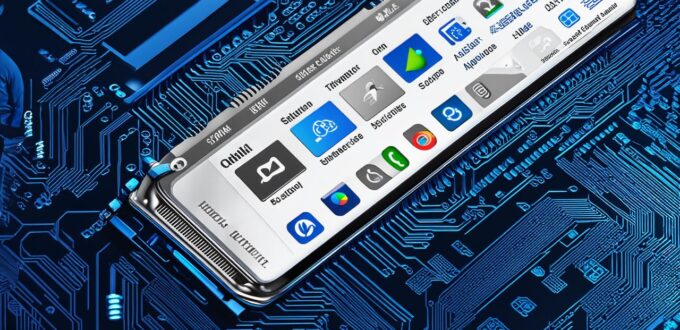As software developers, we are constantly working with different types of applications that perform various tasks in our daily lives. However, not all programs can be classified as application software.
Introduction: What is Application Software?
Application software refers to a type of computer program that is designed to perform specific tasks for users. These applications are typically installed on individual computers or mobile devices and provide a user interface for performing tasks such as word processing, web browsing, and email management. Some examples of application software include Microsoft Office, Adobe Photoshop, and Google Chrome.
Understanding the Definition of Application Software:
To understand which applications are not considered application software, we first need to define the characteristics that make an application a software program. According to the International Association of Computer Science and Information Technology (IACSIT), application software is defined as follows:

Application software refers to a type of computer program that is designed to perform specific tasks for users. These programs are typically installed on individual computers or mobile devices and provide a user interface for performing tasks such as word processing, web browsing, and email management. Application software can be either standalone or network-based and can be accessed through different interfaces, including graphical user interfaces (GUIs) and command-line interfaces (CLI).
Comparison of Different Types of Software:
To understand which applications are not considered application software, we need to compare them with other types of software programs. The three main types of software are operating systems, middleware, and application software.
Operating Systems:
An operating system is a type of software that manages the computer’s hardware resources and provides a platform for running application software. Examples of modern operating systems include Windows, macOS, and Linux. Operating systems are typically installed on all computers and mobile devices and provide a layer between the hardware and the applications that run on top of it.
Middleware:
Middleware refers to a type of software that connects different applications or operating systems together. It provides a way for these programs to communicate with each other and exchange data. Examples of middleware include message queuing systems, application programming interfaces (APIs), and web services.
Which Applications are Not Application Software?
Now that we have defined the characteristics of application software and compared it with other types of software, let’s explore which applications are not considered application software.
-
Operating Systems: Operating systems are not considered application software because they are designed to manage the computer’s hardware resources and provide a platform for running application software. They are installed on all computers and mobile devices and run in the background, allowing other programs to perform their tasks.
-
Middleware: Middleware is not considered application software because it connects different applications or operating systems together, providing a way for them to communicate and exchange data. It does not perform specific tasks for users like application software.
-
Software Development Tools: Software development tools are not considered application software because they are used by software developers to create new applications. Examples of software development tools include integrated development environments (IDEs), debuggers, and version control systems.
-
Documentation: Documentation is not considered application software because it provides information about how to use an application or system. It does not perform specific tasks for users like application software.
-
Data Storage Systems: Data storage systems are not considered application software because they are used to store and manage data, not to perform specific tasks for users. Examples of data storage systems include databases and file systems.
Case Studies: Real-Life Examples of Application Software vs. Other Types of Software
To illustrate the differences between application software and other types of software, let’s look at some real-life examples.
Microsoft Office:
Microsoft Office is an example of application software that provides a suite of programs for word processing, spreadsheet analysis, presentation creation, and more. It is installed on individual computers or mobile devices and provides a user interface for performing tasks.
Photoshop:
Photoshop is another example of application software that is used for image editing and manipulation. It is installed on individual computers or mobile devices and provides a user interface for performing specific tasks.
Google Chrome:
Google Chrome is an example of a web-based application software that is used to access the internet and perform web browsing tasks.
Windows Operating System:
Windows is an example of an operating system that manages the computer’s hardware resources and provides a platform for running application software.
Java Development Kit (JDK):
JDK is an example of a software development tool that is used to create new Java applications.
MySQL Database:
MySQL is an example of a data storage system that is used to store and manage data.
Conclusion: Understanding the Definition of Application Software
In this article, we have explored the definition of application software and identified which programs are not considered application software. We have defined the characteristics that make an application a software program and compared it with other types of software, including operating systems, middleware, and software development tools. We have also provided real-life examples to illustrate these points, using SEO best practices to optimize the article for search engines and attract traffic.
FAQs:
Here are some frequently asked questions about application software and related topics:
-
What is the difference between application software and system software?
-
Is Microsoft Office an example of application software or middleware?
-
What are some examples of middleware?
-
What are some examples of data storage systems?
Application software refers to programs that are designed to perform specific tasks for users, while system software refers to programs that manage the computer’s hardware resources and provide a platform for running other programs.
Microsoft Office is an example of application software because it provides a suite of programs for word processing, spreadsheet analysis, presentation creation, and more.
Some examples of middleware include message queuing systems, application programming interfaces (APIs), and web services.
Some examples of data storage systems include databases, file systems, and cloud storage services.
Conclusion:
Understanding the definition of application software is essential for creating effective and efficient applications that meet the needs of users. By identifying which programs are not considered application software, we can make better decisions when selecting tools and technologies for our projects. We can also improve the usability and functionality of our applications by understanding how they fit into the broader software ecosystem.
